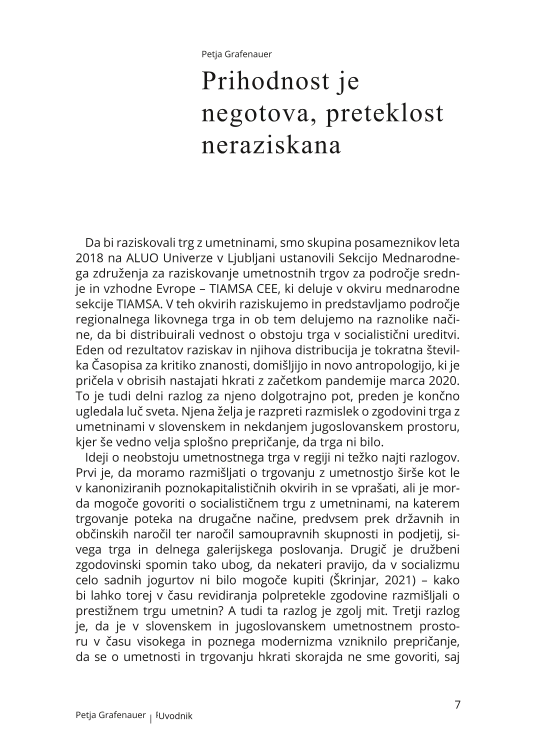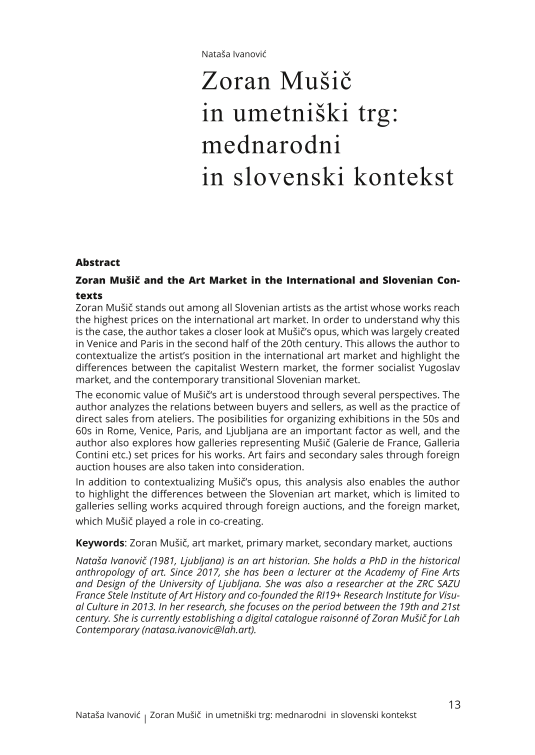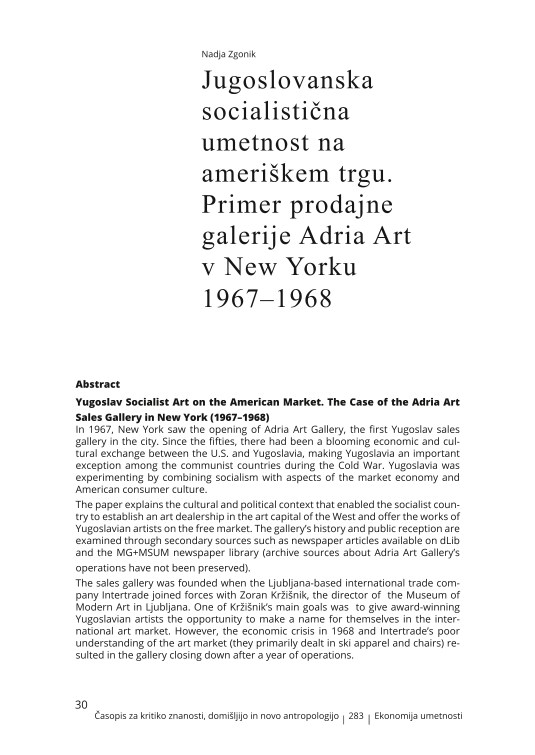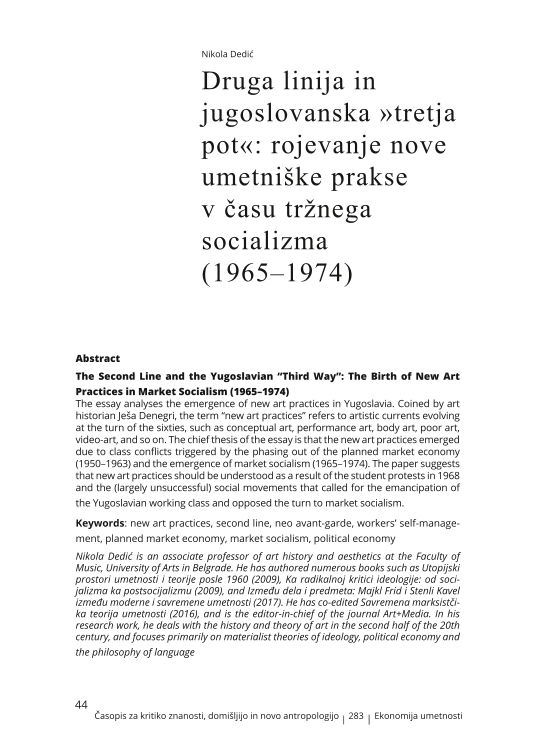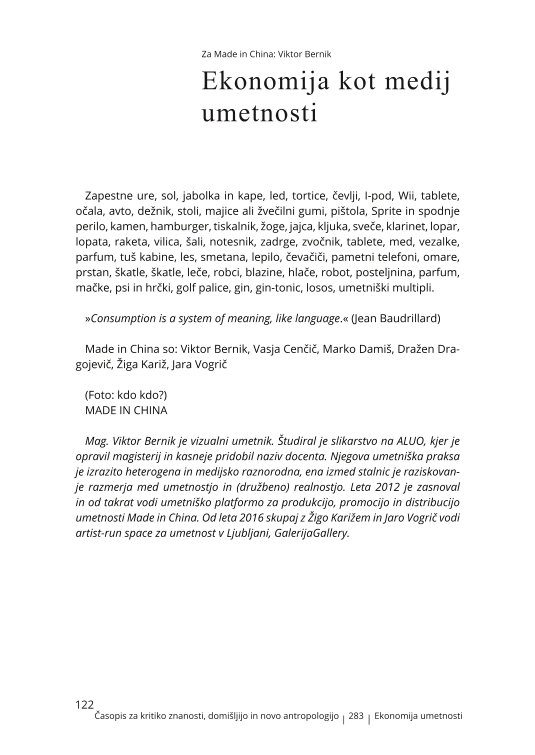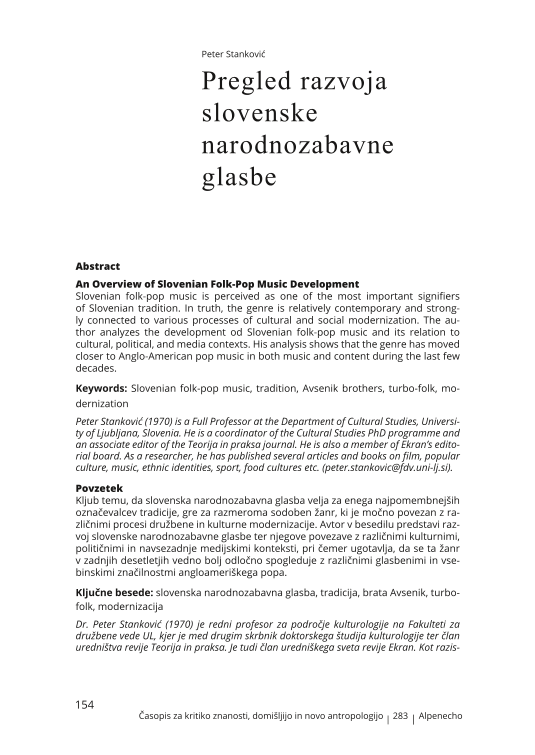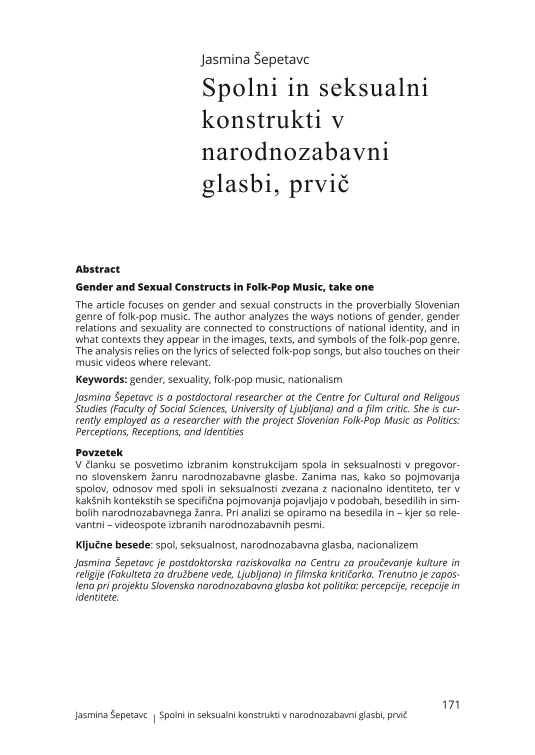Da bi raziskovali trg z umetninami, smo skupina posameznikov leta 2018 na ALUO Univerze v Ljubljani ustanovili Sekcijo Mednarodnega združenja za raziskovanje umetnostnih trgov za področje srednje in vzhodne Evrope – TIAMSA CEE, ki deluje v okviru mednarodne sekcije TIAMSA. V teh okvirih raziskujemo in predstavljamo področje regionalnega likovnega trga in ob tem delujemo na raznolike načine, da bi distribuirali vednost o obstoju trga v socialistični ureditvi. Eden od rezultatov raziskav in njihova distribucija je tokratna številka Časopisa za kritiko znanosti, domišljijo in novo antropologijo, ki je pričela v obrisih nastajati hkrati z začetkom pandemije marca 2020. To je tudi delni razlog za njeno dolgotrajno pot, preden je končno ugledala luč sveta. Njena želja je razpreti razmislek o zgodovini trga z umetninami v slovenskem in nekdanjem jugoslovanskem prostoru, kjer še vedno velja splošno prepričanje, da trga ni bilo.
Zoran Mušič stands out among all Slovenian artists as the artist whose works reach the highest prices on the international art market. In order to understand why this is the case, the author takes a closer look at Mušič’s opus, which was largely created in Venice and Paris in the second half of the 20th century. This allows the author to contextualize the artist’s position in the international art market and highlight the differences between the capitalist Western market, the former socialist Yugoslav market, and the contemporary transitional Slovenian market.
The economic value of Mušič‘s art is understood through several perspectives. The author analyzes the relations between buyers and sellers, as well as the practice of direct sales from ateliers. The posibilities for organizing exhibitions in the 50s and 60s in Rome, Venice, Paris, and Ljubljana are an important factor as well, and the author also explores how galleries representing Mušič (Galerie de France, Galleria Contini etc.) set prices for his works. Art fairs and secondary sales through foreign auction houses are also taken into consideration.
In addition to contextualizing Mušič’s opus, this analysis also enables the author to highlight the differences between the Slovenian art market, which is limited to galleries selling works acquired through foreign auctions, and the foreign market, which Mušič played a role in co-creating.
In 1967, New York saw the opening of Adria Art Gallery, the first Yugoslav sales gallery in the city. Since the fifties, there had been a blooming economic and cultural exchange between the U.S. and Yugoslavia, making Yugoslavia an important exception among the communist countries during the Cold War. Yugoslavia was experimenting by combining socialism with aspects of the market economy and American consumer culture.
The paper explains the cultural and political context that enabled the socialist country to establish an art dealership in the art capital of the West and offer the works of Yugoslavian artists on the free market. The gallery’s history and public reception are examined through secondary sources such as newspaper articles available on dLib and the MG+MSUM newspaper library (archive sources about Adria Art Gallery’s
operations have not been preserved).
The sales gallery was founded when the Ljubljana-based international trade company Intertrade joined forces with Zoran Kržišnik, the director of the Museum of Modern Art in Ljubljana. One of Kržišnik’s main goals was to give award-winning Yugoslavian artists the opportunity to make a name for themselves in the international art market. However, the economic crisis in 1968 and Intertrade’s poor understanding of the art market (they primarily dealt in ski apparel and chairs) resulted in the gallery closing down after a year of operations.
The essay analyses the emergence of new art practices in Yugoslavia. Coined by art historian Ješa Denegri, the term “new art practices” refers to artistic currents evolving at the turn of the sixties, such as conceptual art, performance art, body art, poor art, video-art, and so on. The chief thesis of the essay is that the new art practices emerged due to class conflicts triggered by the phasing out of the planned market economy (1950–1963) and the emergence of market socialism (1965–1974). The paper suggests that new art practices should be understood as a result of the student protests in 1968 and the (largely unsuccessful) social movements that called for the emancipation of the Yugoslavian working class and opposed the turn to market socialism.
Art sales were happening in Slovenia long before the commercial art gallery scene was formally established. Artworks were changing hands at art exhibitions, fairs, antique stores, picture framing workshops, as well as in galleries operating within companies, institutions, and other settings tolerated by the government. Artworks were also available for purchase in unofficial commercial art galleries, which formalized their activities in the nineties after being recognized by the new authorities. By interviewing gallery owners and other market participants and examining written records, media sources and archives, the author offers an overview of art dealership in commercial art galleries in Slovenia during the nineties. The Slovenian gallery scene enjoyed a significant boom in this period and entered its so-called golden age. The paper examines the reasons behind this surge, as well as the differences between Slovenian and foreign, i.e. Western art markets.
The article is based on the assumption that state legislature and its enforcement is playing a key role in the Slovenian art market at the beginning of the 21st century. This assumption is substantiated with a short history of the unsuccessful attempts to establish a legal framework for the country’s art market. After cataloguing these unsuccessful attempts, the author focuses on what she describes as the sole example of good practices when it comes to the state’s support of the Slovenian market: opportunities for artists to participate in international art fairs. P74 Gallery, a small Slovenian non-governmental organization for visual art, is used to highlight this practice.
In 2005, the Slovenian Ministry of Culture attempted to regulate the art market through various methods, but none of the suggested methods were comprehensive enough or adopted legally. The efforts of the Ministry of Culture, which tried to include other ministries into finding solutions, were in vain. The main indicators used in the analysis is the number of galleries and artists present on international art fairs and an interview with gallery director Tadej Pogačar. These indicators are compared and contrasted with the resources that the Ministry of Culture has allocated to the art market in individual years.
Valuing Art and Autonomous Spaces: The Case of the Metelkova City Autonomous Cultural Zone
(
The article analyses the relationships between art, space, and autonomy, that autonomous zones use as the foundation for their resistance against the hegemony of capitalist production. Art and its value are dependent upon commodification and the »art market«, which are inevitably inscribed with capitalist and power codes. The article is based on semi-structured interviews with several artists from the Metelkova City autonomous zone. The author investigates their artistic activities and attempts to understand whether it is possible to escape the hegemonical way of art valorization – is it possible to valorize art on the basis of its effect on autonomous organization, solidarity, and enhancement of freedom? The symbolic value of an art work can play an important role in the preservation of space when it is integrated in broader community structures based on the principles of self-organization, autonomy, horizontality, and solidarity. As such, art is one of the main pilars of autonomous communities. Space and community give artistic engagement symbolic value and redefine the value of art. Value therefore derives from cultural and political codes of the autonomous space – the space creates a new, utopian dimension of art, and takes into account the importance of alternative, solidary organization of social and economic life.
Zapestne ure, sol, jabolka in kape, led, tortice, čevlji, I-pod, Wii, tablete, očala, avto, dežnik, stoli, majice ali žvečilni gumi, pištola, Sprite in spodnje perilo, kamen, hamburger, tiskalnik, žoge, jajca, kljuka, sveče, klarinet, lopar, lopata, raketa, vilica, šali, notesnik, zadrge, zvočnik, tablete, med, vezalke, parfum, tuš kabine, les, smetana, lepilo, čevačiči, pametni telefoni, omare, prstan, škatle, škatle, leče, robci, blazine, hlače, robot, posteljnina, parfum, mačke, psi in hrčki, golf palice, gin, gin-tonic, losos, umetniški multipli.
»Consumption is a system of meaning, like language.« (Jean Baudrillard)
Zgodovina marksizma nas uči — in premalokrat izuči — da najprej obstoji ponudba (blaga; storitev), šele posledično pride do povpraševanja. Ne da bi se hoteli na tem mestu spustiti do naslednje, kritične faze, v kateri začno delovati bolj ali manj zapletena družbena (produkcijska) razmerja in kjer se porodi tržna vrednost, moramo takoj dodati, da se ponudba pojavi tako historično kakor »vsebinsko«, predvsem pa zanjo, za samo njeno pojavnost nikakor ni značilno ali obvezujoče, da bi bila ovita v meglo oziroma v »sivo območje« ekonomske špekulacije. Sam »kulturni kapital« (Bourdieu) ponudbe, tako rekoč njena »začetna« presežna vrednost, je namreč precej obširnejša, kakor to lahko objame poznejše morebitno povpraševanje na trgu. Za naš namen je poučno, da si ogledamo, kako je s tem kapitalom na področjih »žive« kulture in umetnosti, kajti pri njiju se kristalno jasno pokaže, česa vse ju oropa trg, ko naposled pride do povpraševanja.
Drage bralke in bralci, dobrodošli v tematskem bloku Alpenecho, v katerem analitično in kritično, pa tudi prostoimprovizacijsko uglašujemo in razglašujemo slovensko narodnozabavno glasbo (NZG). V alpskih odmevih NZG1 se že od zgodnjih petdesetih let prejšnjega stoletja, ko so z zvočnotehnično in glasbenostilsko modernizacijo partikularnih ljudskih glasbenih idiomov začeli oberkrajnerski »Avseniki«, akumulira simbolen in afektiven repozitorij nacionalnih, etničnih, razrednih in nasploh kulturnopolitičnih identifikacij in bojev. Če že ne vse to, pa NZG odmeva v ozadju marsikaterega družbenega dogodka, nedeljskega kosila, spontanega žura ali vsakdanjega življenja v državi, ki se želi tako simbolno kot geografsko umestiti na t. i. sončno stran Alp.
Slovenian folk-pop music is perceived as one of the most important signifiers of Slovenian tradition. In truth, the genre is relatively contemporary and strongly connected to various processes of cultural and social modernization. The author analyzes the development od Slovenian folk-pop music and its relation to cultural, political, and media contexts. His analysis shows that the genre has moved closer to Anglo-American pop music in both music and content during the last few decades.
The article focuses on gender and sexual constructs in the proverbially Slovenian genre of folk-pop music. The author analyzes the ways notions of gender, gender relations and sexuality are connected to constructions of national identity, and in what contexts they appear in the images, texts, and symbols of the folk-pop genre. The analysis relies on the lyrics of selected folk-pop songs, but also touches on their music videos where relevant.
The article places Slovenian folk-pop music in the broader context of folk-pop genres of the Western Balkans. In this context, the Alpine and exclusively Slovene character of this genre is perceived as a symptom of a distancing from the Balkans, which is a ubiquitous theme in the Balkans. This calls for a theoretical reflection that would abandon the practice of focusing on exposing the differences to the (Balkan) Other: a comparison between (Balkan) turbo-folk and Slovene folk-pop music.
This analysis shows that both genres share a similar position within the cultural and class contradictions characteristic for the transition to post-socialist countries that emerged in the territory of former Yugoslavia. Both genres also deal with modernization, but the complete transition on the rural-urban and regional-global axes is only represented in turbo-folk. Folk-pop music, on the other hand, largely doesn’t deal with themes related to urban life.
This difference is also manifested in the sonic characteristics of the two genres: turbo-folk is a hybrid genre that combines traditional musical conventions with global trends in popular music, while Slovene folk-pop music is more conservative, traditional, and uniform. This difference can be explained through the lens of class analysis: the imaginary of turbo-folk corresponds to the disappearance of the middle class, while the imaginary of folk-pop music is the imaginary of the rural middle class.




